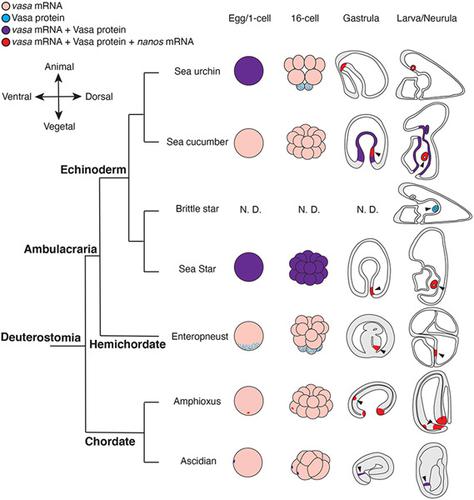当前位置:
X-MOL 学术
›
Evol. Dev.
›
论文详情
Our official English website, www.x-mol.net, welcomes your
feedback! (Note: you will need to create a separate account there.)
Evidence for BMP‐mediated specification of primordial germ cells in an indirect‐developing hemichordate
Evolution and Development ( IF 2.6 ) Pub Date : 2020-12-01 , DOI: 10.1111/ede.12361 Ching‐Yi Lin, Jr‐Kai Yu, Yi‐Hsien Su
Evolution and Development ( IF 2.6 ) Pub Date : 2020-12-01 , DOI: 10.1111/ede.12361 Ching‐Yi Lin, Jr‐Kai Yu, Yi‐Hsien Su

|
Primordial germ cells (PGCs) are specified during development by either one of two major mechanisms, the preformation mode or the inductive mode. Because the inductive mode is widely employed by many bilaterians and early branching metazoan lineages, it has been postulated as an ancestral mechanism. However, among the deuterostome species that have been studied, invertebrate chordates use the preformation mode, while many vertebrate and echinoderm species are known to utilize an inductive mechanism, thus leaving the evolutionary history of PGC specification in the deuterostome lineage unclear. Hemichordates are the sister phylum of echinoderms, and together they form a clade called Ambulacraria that represents the closest group to the chordates. Thus, research in hemichordates is highly informative for resolving this issue. In this study, we investigate the developmental process of PGCs in an indirect‐developing hemichordate, Ptychodera flava. We show that maternal transcripts of the conserved germline markers vasa, nanos, and piwi1 are ubiquitously distributed in early P. flava embryos, and these genes are coexpressed specifically in the dorsal hindgut starting from the gastrula stage. Immunostaining revealed that Vasa protein is concentrated toward the vegetal pole in early P. flava embryos, and it is restricted to cells in the dorsal hindgut of gastrulae and newly hatched larvae. The Vasa‐positive cells later contribute to the developing trunk coeloms of the larvae and eventually reside in the adult gonads. We further show that bone morphogenetic protein (BMP) signaling is required to activate expression of the germline determinants in the gastrula hindgut, suggesting that PGC specification is induced by BMP signaling in P. flava. Our data support the hypothesis that the inductive mode is a conserved mechanism in Ambulacraria, which might even trace back to the common ancestor of Deuterostomes.
中文翻译:

在间接发育的半脊索动物中,BMP 介导的原始生殖细胞特异性的证据
原始生殖细胞 (PGC) 在发育过程中由两种主要机制之一指定,即预形成模式或诱导模式。因为归纳模式被许多双边动物和早期分支的后生动物谱系广泛采用,它被假定为一种祖先机制。然而,在已研究的氘核动物物种中,无脊椎动物脊索动物使用预形成模式,而已知许多脊椎动物和棘皮动物物种利用诱导机制,从而使氘核动物谱系中PGC规范的进化历史不清楚。半脊索动物是棘皮动物的姐妹门,它们一起形成了一个叫做 Ambulacria 的进化枝,代表了最接近脊索动物的群体。因此,对半脊索动物的研究对于解决这个问题非常有用。在这项研究中,黄翼龙。我们表明,保守的生殖系标记vasa、nanos和piwi1的母体转录物普遍分布在早期的黄体假单胞菌胚胎中,并且这些基因从原肠胚期开始在背侧后肠中特异性地共表达。免疫染色显示 Vasa 蛋白在早期P. flava中集中向植物极胚胎,它仅限于原肠胚和新孵化的幼虫后肠背侧的细胞。Vasa 阳性细胞后来有助于幼虫的躯干体腔发育,并最终驻留在成虫性腺中。我们进一步表明,骨形态发生蛋白 (BMP) 信号传导是激活原肠胚后肠中种系决定簇的表达所必需的,这表明 PGC 规范是由P. flava中的 BMP 信号传导诱导的。我们的数据支持这样的假设,即感应模式是 Ambulacria 中的一种保守机制,它甚至可以追溯到 Deuterostomes 的共同祖先。
更新日期:2021-01-05
中文翻译:

在间接发育的半脊索动物中,BMP 介导的原始生殖细胞特异性的证据
原始生殖细胞 (PGC) 在发育过程中由两种主要机制之一指定,即预形成模式或诱导模式。因为归纳模式被许多双边动物和早期分支的后生动物谱系广泛采用,它被假定为一种祖先机制。然而,在已研究的氘核动物物种中,无脊椎动物脊索动物使用预形成模式,而已知许多脊椎动物和棘皮动物物种利用诱导机制,从而使氘核动物谱系中PGC规范的进化历史不清楚。半脊索动物是棘皮动物的姐妹门,它们一起形成了一个叫做 Ambulacria 的进化枝,代表了最接近脊索动物的群体。因此,对半脊索动物的研究对于解决这个问题非常有用。在这项研究中,黄翼龙。我们表明,保守的生殖系标记vasa、nanos和piwi1的母体转录物普遍分布在早期的黄体假单胞菌胚胎中,并且这些基因从原肠胚期开始在背侧后肠中特异性地共表达。免疫染色显示 Vasa 蛋白在早期P. flava中集中向植物极胚胎,它仅限于原肠胚和新孵化的幼虫后肠背侧的细胞。Vasa 阳性细胞后来有助于幼虫的躯干体腔发育,并最终驻留在成虫性腺中。我们进一步表明,骨形态发生蛋白 (BMP) 信号传导是激活原肠胚后肠中种系决定簇的表达所必需的,这表明 PGC 规范是由P. flava中的 BMP 信号传导诱导的。我们的数据支持这样的假设,即感应模式是 Ambulacria 中的一种保守机制,它甚至可以追溯到 Deuterostomes 的共同祖先。











































 京公网安备 11010802027423号
京公网安备 11010802027423号